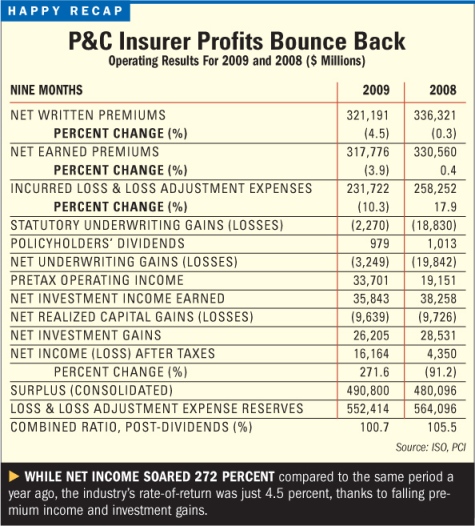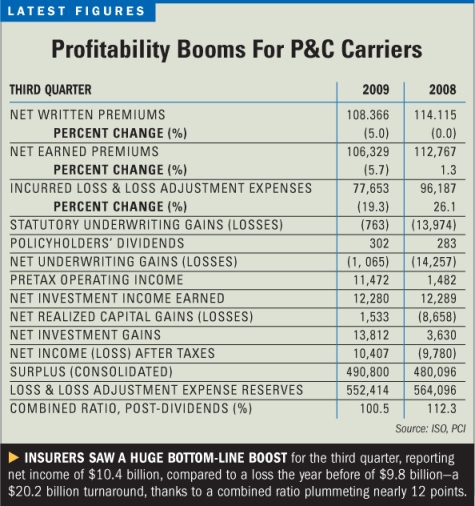The property and casualty insurance industry's consolidated net income through the first three quarters of 2009 improved dramatically–a 272 percent turnaround compared to the same period last year–although association leaders warn there remain plenty of reasons for concern.
Net income for the period improved by close to $12 billion, rising to $16.2 billion, according to a report on the industry's consolidated nine-month results released by the Jersey City, N.J.-based Insurance Services Office Inc., and the Property Casualty Insurers Association of America, headquartered in Des Plaines, Ill.
The industry's rate-of-return on average policyholders' surplus also improved nearly fourfold–from 1.2 percent for the first nine months in 2008 to 4.5 percent this year.
The nine-month results were helped by a big drop in net losses on underwriting, improving $16.6 billion to a loss of only $3.2 billion during the period, compared to $19.8 billion a year earlier.
The industry's combined ratio for the first three quarters improved 4.8 points to a near breakeven 100.7. However, the report noted, if there had not been a decline in claim costs, the combined ratio would have risen 3.5 points.

Indeed, the industry's net written premiums fell 4.5 percent in the first nine months, down $15 billion to $321 billion, while net investment gains were down 8 percent to $26 billion.
In a statement, Michael R. Murray, ISO's assistant vice president for financial analysis, said that despite the improvement in annualized rate of return, the rate was only half of what it usually is.
He noted that for the 24 years ISO has collected consolidated industry-wide data, the rate of return averaged 8.7 percent. He cited the “poor results for mortgage and financial guaranty insurers through nine-month 2009″ as the main factors “dragging down the industry's rate of return year-to-date.”
David Sampson, PCI's president and chief executive officer, also saw some dark clouds in the results amid the silver linings.
“While the 100.7 percent combined ratio for nine-months 2009 compares favorably with the 104.8 percent average combined ratio for the first nine months of every year since 1986, today's low interest rates and investment yields mean insurers must now post significantly better underwriting results just to be as profitable as they once were,” said Mr. Sampson.
“For example, for nine-months 1986, insurers achieved a 14.9 percent annualized overall rate-of-return with a combined ratio of 108 percent,” he noted. “For nine-months 2009, insurers' annualized rate of return was just 4.5 percent, even though the combined ratio was 7.3 percentage points better [than in 1986].”
However, he added that “with insurers' annualized rate-of-return showing some growth, the increase in policyholders' surplus is yet another welcome sign that regulators and consumers can continue relying on the financial strength of property and casualty insurers despite lingering problems in the banking sector.”
He said p&c “insurance failures remain extremely rare events but, year-to-date through Dec. 19, regulators had seized 140 banks. Insurers' superior performance reflects the strength of their balance sheets.”

Mr. Sampson noted that p&c insurers have $1.2 trillion in funds available “to fulfill their promises to consumers”–a figure he reached by combining $490.8 billion in policyholders' surplus as of Sept. 30 with $552.4 billion in loss and loss adjustment expense reserves and $204.7 billion in unearned premium reserves.
In a separate commentary on the results, Robert P. Hartwig, president of the Insurance Information Institute in New York, said the results “provide solid evidence of a substantial and sustained rebound in profitability for p&c insurers in the wake of the financial crisis that began in mid-2007.”
However, he warned, the economic indicators do “nothing to salve the impact of the ongoing six-year-old soft market, as well as significant reduction in demand for insurance driven by a deep global recession that has destroyed property and liability exposure on a worldwide scale.”
He went on to say that the swing to profitability through three quarters was “first and foremost due to an end of the financial panic that sent stock markets into a freefall following the failure of Lehman Brothers.”
Profits, he noted, were earned entirely in the second and third quarters of this year. And while net income is positive, the industry's 4.5 percent rate of return is “woefully inadequate by any standard.”
Indeed, such a low return, he warned, could lead to the exit of capital and make it difficult to raise new capacity after a “major 'capital event'” particularly in the current economic environment.
“While insurers remain cautious about the economy and financial market conditions, there is guarded optimism that both will continue to improve as the industry moves into 2010,” Mr. Hartwig said.
(To read Mr. Hartwig's complete commentary on third-quarter results, go to: http://www.iii.org/Financial_Results/2009-First-Nine-Months-Results.html.)
Want to continue reading?
Become a Free PropertyCasualty360 Digital Reader
Your access to unlimited PropertyCasualty360 content isn’t changing.
Once you are an ALM digital member, you’ll receive:
- Breaking insurance news and analysis, on-site and via our newsletters and custom alerts
- Weekly Insurance Speak podcast featuring exclusive interviews with industry leaders
- Educational webcasts, white papers, and ebooks from industry thought leaders
- Critical converage of the employee benefits and financial advisory markets on our other ALM sites, BenefitsPRO and ThinkAdvisor
Already have an account? Sign In Now
© 2025 ALM Global, LLC, All Rights Reserved. Request academic re-use from www.copyright.com. All other uses, submit a request to [email protected]. For more information visit Asset & Logo Licensing.








